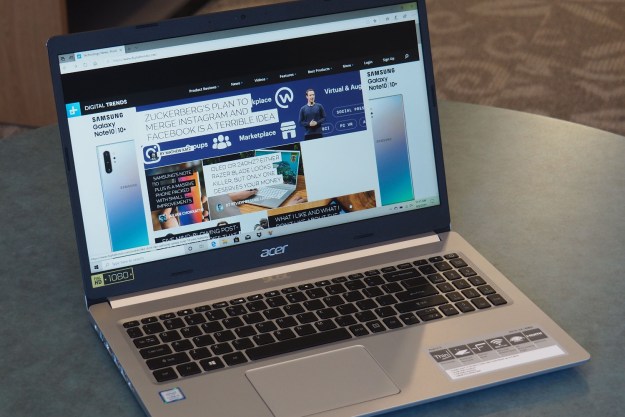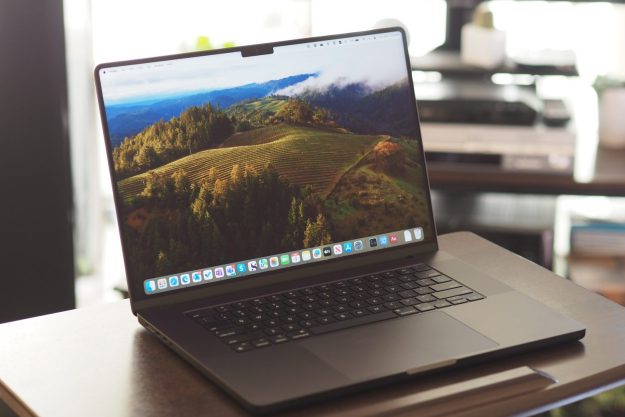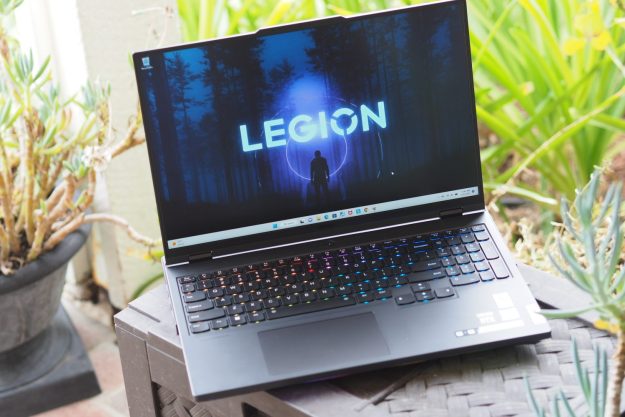
“The Acer Aspire 5 fixes its display and battery life, bringing the best value you’ll find for under $500.”
- Solid productivity performance with an inexpensive upside
- Very good battery life
- A better-than-budget display
- Comfortable keyboard and touchpad
- Better-than-budget aesthetics
- Smaller than the previous version, but still bulky
- Display bezels are still not small enough
If you’re looking for more recent versions of this laptop, take a look at our Acer Aspire 5 (2020) and Acer Aspire 5 (2021) reviews.
- Nothing wrong with the build quality at prices like this
- A better keyboard and touchpad than you might expect
- A better-than-budget display and competent sound
- Performance that matches the components – and you can pay a little for a lot more
- Gaming isn’t this laptop’s forte
- Battery life was a nice surprise
- Our Take
Not everyone can afford to spend a thousand bucks on one of the best laptops, and fortunately, that doesn’t mean you have to buy a piece of junk. No, you won’t get sexy or exciting for under $500. But if you’re careful, you can get great performance, battery life, and features — especially if you go for the $400
What do you get for so little money? In terms of components, there’s an 8th-gen dual-core i3-8145U CPU, 4GB of
So, does the
Nothing wrong with the build quality at prices like this
Okay, let’s be right up front here: You’re not going to get an all-aluminum (or magnesium, or whatever) construction that feels like a solid chunk of metal for $400. But unlike the previous model of the Aspire 5, which we found had a lid that was far too flexible, this version is a lot more rigid – probably due to its aluminum frame.
The plastic keyboard deck resists flexing, and the plastic bottom of the chassis is solid. You’ll have no real complaints about build quality. And the lid is stiff but holds its place well, while being able to extend to a full 180 degrees for sharing information with friends and colleagues.

You also won’t have too many complaints – or accolades – about the aesthetics, either. There’s nothing wrong with the look, exactly, at least in our very typical silver color scheme. The Acer logo on the lid is the only real adornment, and otherwise, this is a very simply designed laptop. Maybe if you chose one of the other color schemes, such as the black, red, light blue or dark blue, then you’d have a bit more panache. If you’re looking for something that stands out, the Aspire 5 isn’t for you – but at these prices, do you really care?
Two primary changes were made from the previous version. First, the bezels are smaller, especially along the sides. The Aspire 5 isn’t a member of the tiny bezel club, but it looks more modern than its predecessor. Second, it’s also smaller in all dimensions, including being thinner at 0.71 inches (compared to 0.85 inches) and lighter at 3.97 pounds (versus 4.63 pounds). It can’t quite live up to the 0.66 inches and 3.72 pounds of its budget competitor, the Lenovo IdeaPad 530s, but it’s close enough for government work.
The keyboard and touchpad are better than you’d expect for the price.
We’ll note that our favorite budget laptop, the Acer Aspire E 15, is reaching its end of life. That means that we’ll be looking for a replacement recommendation and given just how much more svelte the Aspire 5 is than the Aspire E 15 (1.19 inches thick and 5.27 pounds), the latest Acer might be a good alternative. We’ll continue to evaluate it for just that purpose.
Perhaps paradoxically, budget
A better keyboard and touchpad than you might expect
It seems like lately, we’re seeing fewer and fewer cheap, mushy keyboards, and that makes us very happy. Accordingly, the Aspire 5’s keyboard punches way above its price. It’s a very typical island keyboard with black keys and white letters, and there’s the bonus of a backlight — which is unusual for budget

The touchpad is also very good, with plenty of size, a comfortable plastic surface, and buttons that aren’t too loud. It’s also a Microsoft Precision touchpad, meaning it provides excellent support for Windows 10’s multitouch gestures. It’s easily the equal of
In terms of input, that’s all you get, though. There’s no touch display, which is par for the budget course, and there’s no Windows 10 Hello mechanism for password-less login. That’s a bummer, but again, you must give up something to bring in a laptop for $400.
A better-than-budget display and competent sound
The 2018 Aspire 5 had a mediocre display, and in fact that was one of the reasons why we gave it a low score. Acer took note, apparently, because they equipped the 2019 version with a much better 15.6-inch IPS Full HD (1,920 x 1,080) panel.
First, the difference was made obvious by our colorimeter. Colors are a bit muted, at just 64% of the sRGB gamut and 47% of AdobeRGB. If you spent a few hundred dollars more, you’d get closer to a 100% in sRGB. Nonetheless, the screen quality here is competitive with
Don’t misunderstand us – these aren’t impressive colors if you need to edit photos or video. And if you’re looking for colors that really pop on web sites and in your own photo collection, then you’ll be disappointed with this display. But you have to give something up to fit a Full HD display into this kind of budget, and color depth and accuracy are usually the first to go. And frankly, we don’t think most people won’t find this display disappointing even in these metrics.
Simply put, this is an impressive display for a $400 laptop.
Brightness was average at 238 nits, below the 300 nits we like to see but still competitive with even some premium
The Aspire 5’s display is another area where it matches our favorite Aspire E 15, and gives it yet another opportunity to compete in the “best budget laptop” category. Simply put, this is an impressive display for a $400 laptop. And it’s not just our colorimeter that thinks so – we enjoyed using this display far more than on most budget
Audio was also surprisingly good, with plenty of volume without any distortion when turned all the way up. Mids and highs were strong, and there was even a hint of bass. You could easily binge Netflix using these speakers, although music would benefit from a good pair of
Performance that matches the components – and you can pay a little for a lot more
Our $400 review unit equipped a dual-core Core i3-8145U CPU. That’s not much faster than Intel’s low-power Y-series CPUs, but it too uses less power than hungrier processors. When coupled with 4GB of
Looking at the Geekbench 4 synthetic benchmark, the Aspire 5 was a middling performer, as expected. It scored 4,197 in the single-core test and 8,028 in the multi-core test. Interestingly, that falls behind the HP Spectre Folio with its Core i7-8500Y dual-core low-power CPU. The Aspire 5 was also well behind the Core i5
In our real-world Handbrake test that encodes a 420MB video to H.265, the Aspire 5 beat out the Spectre Folio but was considerably slower at 484 seconds than the rest of the machines in our list. Even the AMD Ryzen 5 2500u in the Acer Aspire 3 was faster.
Next, the Aspire 5 came equipped with a 128GB Kingston PCIe SSD, which is a great feature for such a low-cost laptop. Usually, you’ll find spinning hard disks in this price range, or at best slower SATA SSDs. And so while 128GB isn’t a ton of storage, its performance as plenty quick. In the CrystalDiskMark 5 test, it scored 1,007 megabytes per second (MB/s) in the read test and 492 MB/s second in the write test. That beats out the SATA drives in our test and even the Intel Optane-backed hard disk drive (HDD) in the

So, what does that mean for you, the potential buyer? The entry-level Aspire 5 isn’t the fastest benchmarking laptop around, but during our testing we found its performance more than good enough for the usual productivity tasks, surfing the web, watching Netflix, and the like. It’ll do everything the usual office worker or student asks of it without complaint – especially for $400.
If you’re worried about this laptop getting too hot to handle, don’t. Even at full load, the Aspire 5 stays cool, and there’s a reason. First, the bottom vents are sufficient to allow a lot of air to pass through the system and keep things cool. And, the fans spin up and get a bit loud. We’re not talking gaming laptop loud here, but it’s more than the usual productivity laptop.
At the same time, we’re tempted to suggest you spend a couple of hundred dollars more and buy the version with a Core i5, 8GB of
Gaming isn’t this laptop’s forte
The $400 Aspire 5 is limited to Intel’s UHD 620 integrated graphics. That means limited gaming chops, and once again, we recommend splurging for the MX250 model. With that discrete graphics on board, you’ll get a bit more out of your Aspire 5.
We ran a couple of benchmarks, though, to see how the Aspire 5 would perform. As expected, it wasn’t great. It scored 791 in the 3DMark synthetic Fire Strike benchmark, which is low. And when we tried to run Fortnite, our experience was equally disappointing. The Aspire 5 managed a paltry eight frames per second (FPS) at 1080p and High graphics settings, and just five FPS at Epic settings.
So, as we’ve been alluding to throughout this review, there’s another option. Pay some extra cash for the version with the MX250 GPU, and you’ll be able to play casual games like this with a much better experience.
Battery life was a nice surprise
Acer packed in 48 watt-hours of battery into the Aspire 5. That’s not a lot for a 15.6-inch Full HD display, but we expected longevity to be assisted by the relatively power-sipping CPU. As it turns out, we were pleasantly surprised by the Aspire 5’s battery life.
To begin with, in our web browsing test that runs through a series of popular web sites, the Aspire 5 performed well against its peers. It managed just over nine hours, a strong score, and missed the Aspire E 15’s score by only nine minutes. And it beat out every other laptop in our comparison group – including the Lenovo IdeaPad 530s by almost three hours.
Next, in our video test that loops a local Avengers trailer until the battery ran out, the Aspire 5 lasted for just over 13 hours. Again, that’s a strong score that bests our comparison group and competes with some premium
Performance is more than good enough for the usual office worker or student – especially for $400.
Finally, in our most demanding Basemark web benchmark, the Aspire 5 lasted for almost exactly four hours. That’s not a record-breaking score, but it’s solid for the battery capacity and display size. The IdeaPad 530s, for example, only managed around two and a half hours, while the Aspire E15 exactly matched the Aspire 5.
The Aspire 5 isn’t the thinnest or lightest 15.6-inch laptop around, that much is clear. But for the typical productivity worker, there’s a very good chance that you’ll be able to get in a full working day without carrying around your charger. And that’s not nothing.
Our Take
It’s a good thing that the Aspire 5 received its refresh so soon before the Aspire E 15 is slated to be discontinued. At this point, Acer can likely maintain its place at the top of the budget laptop heap. Yes, we like this $400 version, and we’re giving it a strong score on its own merits. But we suspect that we’d give just as strong an endorsement to the $660 version with the faster CPU, more
Is there a better alternative?
If you can still buy it, the
Acer’s Swift 3 is another option, particularly if you’re considering the more expensive version of the Aspire 5. It costs $1,000 for a Core i7-8565U, 8GB of
Finally, you could consider the Lenovo IdeaPad 530s. It’s a bit better looking than the Aspire 5, and it has a slightly better build quality. It costs $735 as we reviewed it, with a Core i5-8250U CPU, 8GB of
How long will it last?
If you spend $400 on a laptop, then you don’t necessarily expect it to last a decade. And while the Aspire 5 feels like it’ll last a while, it’s held back by its relatively slow, dual-core CPU. The 1-year standard warranty isn’t quite as disappointing at this price as it is when you’re spending over $1,000 for a laptop.
Should you buy it?
Yes. The Aspire 5, whether in its $400 review configuration or its slightly more expensive $660 model with much better components, is our new favorite budget laptop.
Editors' Recommendations
- Acer Swift X 16 hands-on review: A tantalizing preview
- Acer Ryzen 5000 updates coming to Aspire 5 and 7, starting at just $550


